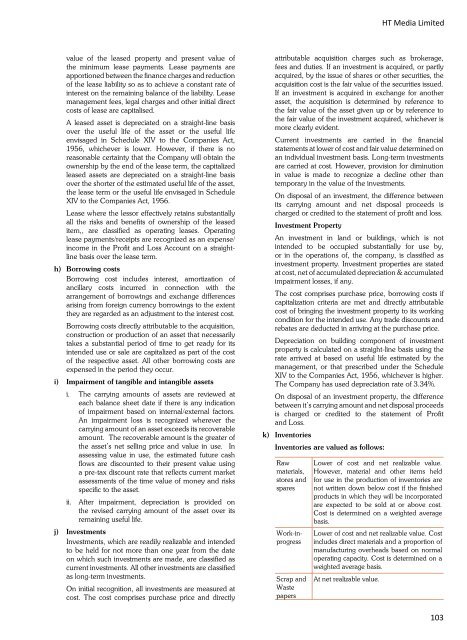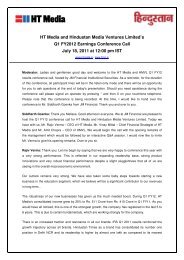Download latest annual report - HT Media
Download latest annual report - HT Media
Download latest annual report - HT Media
You also want an ePaper? Increase the reach of your titles
YUMPU automatically turns print PDFs into web optimized ePapers that Google loves.
value of the leased property and present value of<br />
the minimum lease payments. Lease payments are<br />
apportioned between the finance charges and reduction<br />
of the lease liability so as to achieve a constant rate of<br />
interest on the remaining balance of the liability. Lease<br />
management fees, legal charges and other initial direct<br />
costs of lease are capitalised.<br />
A leased asset is depreciated on a straight-line basis<br />
over the useful life of the asset or the useful life<br />
envisaged in Schedule XIV to the Companies Act,<br />
1956, whichever is lower. However, if there is no<br />
reasonable certainty that the Company will obtain the<br />
ownership by the end of the lease term, the capitalized<br />
leased assets are depreciated on a straight-line basis<br />
over the shorter of the estimated useful life of the asset,<br />
the lease term or the useful life envisaged in Schedule<br />
XIV to the Companies Act, 1956.<br />
Lease where the lessor effectively retains substantially<br />
all the risks and benefits of ownership of the leased<br />
item,, are classified as operating leases. Operating<br />
lease payments/receipts are recognized as an expense/<br />
income in the Profit and Loss Account on a straightline<br />
basis over the lease term.<br />
h) Borrowing costs<br />
Borrowing cost includes interest, amortization of<br />
ancillary costs incurred in connection with the<br />
arrangement of borrowings and exchange differences<br />
arising from foreign currency borrowings to the extent<br />
they are regarded as an adjustment to the interest cost.<br />
Borrowing costs directly attributable to the acquisition,<br />
construction or production of an asset that necessarily<br />
takes a substantial period of time to get ready for its<br />
intended use or sale are capitalized as part of the cost<br />
of the respective asset. All other borrowing costs are<br />
expensed in the period they occur.<br />
i) Impairment of tangible and intangible assets<br />
i. The carrying amounts of assets are reviewed at<br />
each balance sheet date if there is any indication<br />
of impairment based on internal/external factors.<br />
An impairment loss is recognized wherever the<br />
carrying amount of an asset exceeds its recoverable<br />
amount. The recoverable amount is the greater of<br />
the asset’s net selling price and value in use. In<br />
assessing value in use, the estimated future cash<br />
flows are discounted to their present value using<br />
a pre-tax discount rate that reflects current market<br />
assessments of the time value of money and risks<br />
specific to the asset.<br />
ii. After impairment, depreciation is provided on<br />
the revised carrying amount of the asset over its<br />
remaining useful life.<br />
j) Investments<br />
Investments, which are readily realizable and intended<br />
to be held for not more than one year from the date<br />
on which such investments are made, are classified as<br />
current investments. All other investments are classified<br />
as long-term investments.<br />
On initial recognition, all investments are measured at<br />
cost. The cost comprises purchase price and directly<br />
<strong>HT</strong> <strong>Media</strong> Limited<br />
attributable acquisition charges such as brokerage,<br />
fees and duties. If an investment is acquired, or partly<br />
acquired, by the issue of shares or other securities, the<br />
acquisition cost is the fair value of the securities issued.<br />
If an investment is acquired in exchange for another<br />
asset, the acquisition is determined by reference to<br />
the fair value of the asset given up or by reference to<br />
the fair value of the investment acquired, whichever is<br />
more clearly evident.<br />
Current investments are carried in the financial<br />
statements at lower of cost and fair value determined on<br />
an individual investment basis. Long-term investments<br />
are carried at cost. However, provision for diminution<br />
in value is made to recognize a decline other than<br />
temporary in the value of the investments.<br />
On disposal of an investment, the difference between<br />
its carrying amount and net disposal proceeds is<br />
charged or credited to the statement of profit and loss.<br />
Investment Property<br />
An investment in land or buildings, which is not<br />
intended to be occupied substantially for use by,<br />
or in the operations of, the company, is classified as<br />
investment property. Investment properties are stated<br />
at cost, net of accumulated depreciation & accumulated<br />
impairment losses, if any.<br />
The cost comprises purchase price, borrowing costs if<br />
capitalization criteria are met and directly attributable<br />
cost of bringing the investment property to its working<br />
condition for the intended use. Any trade discounts and<br />
rebates are deducted in arriving at the purchase price.<br />
Depreciation on building component of investment<br />
property is calculated on a straight-line basis using the<br />
rate arrived at based on useful life estimated by the<br />
management, or that prescribed under the Schedule<br />
XIV to the Companies Act, 1956, whichever is higher.<br />
The Company has used depreciation rate of 3.34%.<br />
On disposal of an investment property, the difference<br />
between it’s carrying amount and net disposal proceeds<br />
is charged or credited to the statement of Profit<br />
and Loss.<br />
k) Inventories<br />
Inventories are valued as follows:<br />
Raw<br />
materials,<br />
stores and<br />
spares<br />
Work-inprogress<br />
Scrap and<br />
Waste<br />
papers<br />
Lower of cost and net realizable value.<br />
However, material and other items held<br />
for use in the production of inventories are<br />
not written down below cost if the finished<br />
products in which they will be incorporated<br />
are expected to be sold at or above cost.<br />
Cost is determined on a weighted average<br />
basis.<br />
Lower of cost and net realizable value. Cost<br />
includes direct materials and a proportion of<br />
manufacturing overheads based on normal<br />
operating capacity. Cost is determined on a<br />
weighted average basis.<br />
At net realizable value.<br />
103





